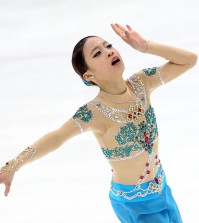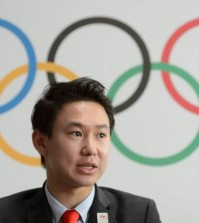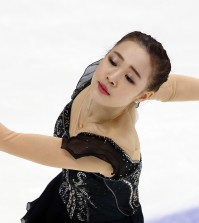- California Assembly OKs highest minimum wage in nation
- S. Korea unveils first graphic cigarette warnings
- US joins with South Korea, Japan in bid to deter North Korea
- LPGA golfer Chun In-gee finally back in action
- S. Korea won’t be top seed in final World Cup qualification round
- US men’s soccer misses 2nd straight Olympics
- US back on track in qualifying with 4-0 win over Guatemala
- High-intensity workout injuries spawn cottage industry
- CDC expands range of Zika mosquitoes into parts of Northeast
- Who knew? ‘The Walking Dead’ is helping families connect
Tale of the tape: Yuna vs. Yulia
Shaping up as the biggest Sochi Olympic event
By Baek Byung-yeul, Kim Tong-hyung
It’s shaping up as the most anticipated showdown of the Olympics.
Kim Yuna, Korea’s figure-skating superstar and defending Olympic champion, hopes to end her career in style, but Yulia Lipnitskaya, the 15-year-old Russian prodigy, appears to be standing in her way.
Heading into the Sochi Games, Kim was thought to be a safe bet for a repeat, despite a foot injury that sidelined her for three months until December.
Her inspiring performance in the Korean national championships in January reduced concerns about her form. Her rivalry with Japan’s Asada Mao has been merely a rumor.
But that was before Lipnitskaya opened the Olympics with a bang, dominating the women’s side of the team competition, where Russia took the gold medal, and emerging as a candidate to upset Kim in next week’s individual program.
Korean media outlets have spent the last couple of days spilling a massive amount of ink discussing and dissecting whether Lipnitskaya has what it takes to beat Kim.
The consensus of experts interviewed by The Korea Times is that Kim is still the favorite but Lipnitskaya is not far behind.
“She (Lipnitskaya) comes from a background in rhythmic gymnastics and I can totally see that in her performance on ice,” said Yang Tae-hwa, who won the bronze medal in women’s figure-skating in the 1999 Asian Winter Games held in Korea’s Gangwon Province.
“The first impression you get from her performance is that it’s very bouncy. There’s a musical rhythm to it. Her flexibility is just amazing and that really allows her to display a high level of sophistication in twists and spins.”
In Yang’s opinion, the biggest advantage Kim has over Lipnitskaya is her athleticism. Kim achieves greater speed, height and movement in her jump routines, which are most influential to the outcome in figure skating’s scoring system.
Throughout her career, Kim’s signature move has been the triple lutz-triple toe combination, where she covers an incredible amount of ice with great speed before unleashing a beautiful moment of controlled, airborne violence. Lipnitskaya has yet to display a killer move to match, according to Yang.
“She obviously can’t soar as high as Yu-na does. She doesn’t gather much speed either,” Yang said.
“I am not saying that her jumps aren’t executed with skill because they are. But Yuna always looks comfortable coming in and out of her jumps and Lipnitskaya looks rushed in those routines, which is understandable considering the lack of height and speed.”
Song Doo-heon, a Yongin Songdam College professor and figure skating analyst, agreed with Yang’s observation, although he said that Lipnitskaya shows a higher level of skill in spins than Kim. He predicts Kim will edge Lipnitskaya for the gold medal, but isn’t willing to bet his house on it.
Yuna: better jumper
Figure-skating competitions are comprised of two segments — a short routine in which skaters perform a set of technical elements, and the free skate, which is a longer, higher-scoring routine that allows for more creative freedom. A panel of nine judges will score on choreography and technical proficiency.
This process of judging remains more art than science, and Song expects Lipnitskaya competing in front of her home crowd to have a favorable effect on her scoring.
While Lipnitskaya did impress in the team event, Song wondered whether her program component score — where judges rate skating skills, transitions, performance, choreography and interpretation on a scale of 0 to 10 — was inflated.
“There’s no denying that Lipnitskaya has a surprising level of talent, especially when considering she is only 15 years old. If this was a competition on a neutral site, I believe Yu-na would defeat her by a margin of around 15 points, but since this is Russia, I believe the difference will be about half of that,” Song said.
“If you force me to give you a number, I would say Yu-na will score about 220 points combined for the short program and free skate. Let’s put Lipnitskaya at 214.”
While talking about Asada has become unfashionable, Yang believes the Japanese skater’s talent and skills gives her a puncher’s chance in any event she enters.
Asada, who recently finished third in the Japanese national championships, is probably the most athletically-gifted skater in the field, being the only woman in the world who can land triple axels with anything resembling regularity. However, she has yet to execute the jump cleanly this season.
“I believed Asada performed well in Vancouver. Although there were some technical flaws, she definitely deserved her silver medal,” Yang said.
“Often, the problem with Asada is that she becomes so focused with her triple axel that she loses concentration in other jump routines, steps and spins. As a result, she often becomes tentative and struggles to gather speed before jumping, which leads to mistakes. It would be special if she could get it all together for the big moment.”
Kim arrived in Sochi Wednesday night and is expected to start practicing at the Iceberg Skating Palace on Sunday. The women’s individuals will begin on Feb. 20 at the venue.
After her historic performance in the 2010 Vancouver Olympics, when she took the gold with a world-record of 228.56 points, Kim is now looking to become only the third woman ever to repeat as Olympic champion. She has already ruled out a three-peat, insisting on retiring after the Sochi Games.
“It think it will be a long week before the competition starts,” Kim told reporters on Thursday.
“I did my best in preparing for Vancouver and I did my best in preparing for Sochi. I am ready to display my best performance. If I keep my composure on game day, I think I will be fine.”
















